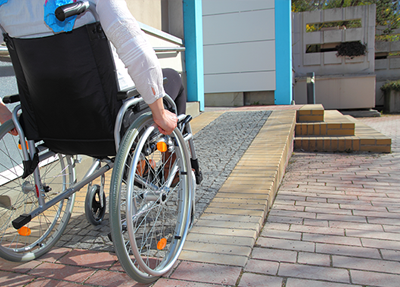Home modifications may involve converting or adapting your environment so you can live independently. Examples of home modifications include replacing regular door handles with ones that open by using a push button; adding handrails on both sides of a staircase and outside steps; installing ramps for so you can come and go from your home by wheelchair or scooter; building a walk-in shower; and lowering kitchen counters. These types of home modifications enable people with disabilities and older adults to “age in place” and live independently.
Here are a few resources and organizations that will help you get information about making your home accessible:
- Rebuilding Together is a nonprofit organization that provides home repair and modification services for low-income families, people with disabilities, seniors and Veterans and military families. Also helps families whose homes have been damaged by natural disasters. Contact your local affiliate for more information.
- The National Resource Center on Supportive Housing and Home Modification promotes aging in place for seniors and people who are aging with a disability. The Center gives families and individuals the knowledge they need to plan for their housing, health and supportive service needs. Check your state’s listings for agencies and organizations near you that can help with home modifications.
- Your local Independent Living Center (ILC) may be able to make some suggestions about how to pay for home modifications such as adding a wheelchair ramp or widening the doorway to your bathroom. ILCs also provide advocacy and support services for people with disabilities, including assistance with housing, health care and independent living skills.
- Easy Access Housing for Easier Living is a brochure from Easter Seals that has tips on how to adapt your home to accommodate a person with a disability. Your local Easter Seals chapter can provide you with information about possible financing options to pay for modifications to make your home accessible.
- Your local Aging and Disability Resource Center (ADRC) may be able to refer you to an organization or company that provides home modifications services. ADRCs offer information on long-term supports and services for older adults and people with disabilities.
- The Department of Veterans Affairs (VA) makes grants available to service members and veterans with certain permanent and total service-connected disabilities to help them buy or build an adapted home, or modify an existing home to accommodate a disability. The two grant programs are the Specially Adapted Housing (SAH) grant and the Special Housing Adaptation (SHA) grant. You can apply online or call VA toll free at 1-800-827-1000 to have a claim form mailed to you. You can also download this helpful Benefits Factsheet.
- According to Eldercare.gov, many minor home modifications and repairs cost between $150 and $2,000. Some home remodeling contractors offer reduced rates and charge sliding-scale fees based on a person’s income and ability to pay. Some Area Agencies on Aging (AAA) have home modification programs or can refer you to other organizations that can help pay for home repairs and modifications.
- The USDA’s Single Family Housing Repair program provides loans to very low-income homeowners to repair, improve or modernize their homes and grants to elderly very low-income homeowners to remove health and safety hazards. Contact your USDA state office for more information about this program.
- Some state housing finance agencies have loan programs that help people with disabilities (or who have a family member living in the household with disabilities) who are buying a home that needs accessibility modifications. Many states have home modification programs that are part of their state Assistive Technology programs. These programs provide low-interest loans to buy assistive technology or to help pay for home modifications and adaptations to make your home safe and accessible.
- The United Spinal Association offers a guide on home modifications that includes information about resources that can help people with spinal cord injuries pay for home modifications. The American Occupational Therapy Association has more information on this subject.
Find more information about home modifications by visiting Disability.gov’s Home Modifications & Repairs section. Use the “Locations” menu on the left side of the page to find home modification programs in your community.
Source: https://www.disability.gov

